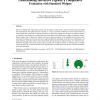117 search results - page 20 / 24 » Exploring affective design for physical controls |
89
Voted
CGF
2010
14 years 11 months ago
2010
Interactive information visualization systems rely on widgets to allow users to interact with the data and modify the representation. We define interactive legends as a class of c...
97
Voted
DAC
2007
ACM
16 years 19 days ago
2007
ACM
Processing and storage of confidential or critical information is an every day occurrence in computing systems. The trustworthiness of computing devices has become an important co...
114
click to vote
ICRA
1994
IEEE
15 years 3 months ago
1994
IEEE
While most previous work in planning manipulation tasks relies on the assumption of quasi-static conditions, there can be situations where the quasi-static assumption may not hold...
102
Voted
NIME
2005
Springer
15 years 5 months ago
2005
Springer
Pluck, ring, rub, bang, strike, and squeeze are all simple gestures used in controlling music. A single motor/encoder plus a force-sensor has proved to be a useful platform for ex...
CHI
2009
ACM
16 years 7 days ago
2009
ACM
In this paper, we explore how to add pointing input capabilities to very small screen devices. On first sight, touchscreens seem to allow for particular compactness, because they ...

